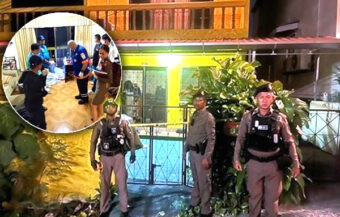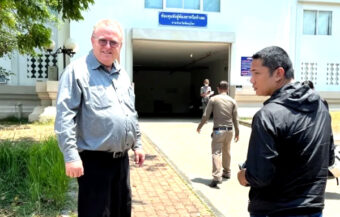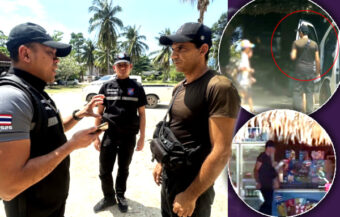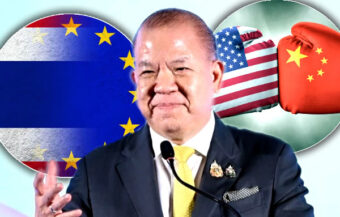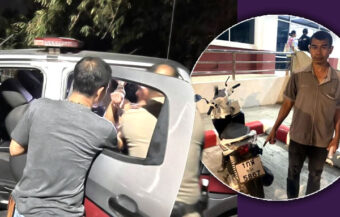Mystery holy man turned up on Monday and dug up newly laid cement where the plaque has been inserted to place roses, photographs of the student protest leaders and a cap emblazoned with the three-fingered salute into the hollow.
A senior police officer on Monday denied any police involvement in the removal of a symbolic plaque installed by the student protest leaders early on Sunday morning which was found missing when the Sanam Luang parade grounds reopened again on Monday after being closed for inspection and repairs at 4 pm on Sunday.
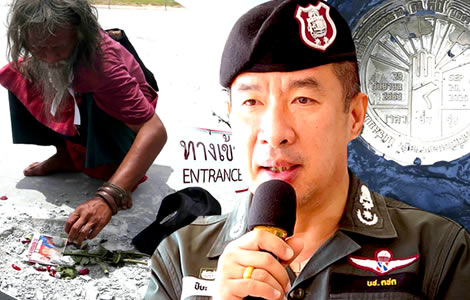
Mystery surrounds the plaque which is referred to as the Khana Ratsadon or People’s Party and a historical one which was laid in the same spot in 1936 to commemorate the 1932 bloodless revolution in Thailand.
Police General Piya Tawichai of the Metropolitan Police on Monday told reporters that charges are quite likely, in due course, against the student organisers of Saturday and Sunday’s protest.
The event attended by up to 50,000 protestors passed off peacefully.
Speeches from the stage, however, on Saturday and Sunday have drawn condemnation from officials and conservative figures alike, for being offensive to the Thai monarchy.
Police not involved with removal of plaque
The Deputy Metropolitan Police Bureau Commissioner emphasised that police were not linked to the disappearance of the symbolically important brass plaque installed at the Sanam Luang parade grounds by student protest leaders on Sunday morning ahead of their march to the Privy Council where they submitted their call for reform of the monarchy.
Sanam Luang closed on Sunday at 4 pm and reopened again on Monday morning when the plaque was found missing.
It is understood that officials from the Bangkok Metropolitan Authority closed off the area on Sunday at 4 pm as workmen undertook a survey and any necessary repairs to the area required after the protest.
On Monday, the local authority reported that the grounds were in relatively good order and that while they would not be calling for the prosecution of protesters, they would report any damage to police officers as requested.
Charges to follow against student leadership
The comments by the senior police officer came as he confirmed to reporters that charges will, most likely, be raised against the protest leadership over the protest activity on Saturday and Sunday.
General Piya explained that there was ample evidence including images, audio and video to convict those involved but declined, as yet, to specify the charges that might be brought.
Conservative figures lodge complaints at police stations against the protest leaders and MPs
On Monday, several conservative leaders and lawmakers lodged complaints with police in Bangkok against the protesters including calls for them to be prosecuted for lèse majesté over their comments relating to the monarchy which, it is claimed, has caused offence and disturbed many Thai people.
Among those who filed complaints was well known Palang Pracharat MP, Sira Jenjaka, who filed a complaint against three fellow MPs for attending the rally and giving the three-fingered salute.
Mr Sira made a statement at Chana Songkhram Police Station against the leader of the Thai Civilised Party, Mongkolkit Suksintharanon, with whom he has a long-running feud as well as the Thai Rak Tham Party leader, Mr Pirawit Ruangluedolapak and the Move Forward Party MP, Mr Natcha Boonchaiinsawat.
Plaque recalled a 1936 version linked with the 1932 revolution that disappeared in April 2017
The brass plaque installed on Sunday morning declared the sovereignty of people in Thailand in strongly worded terms which appeared to question the current role of Thailand’s monarchy.
The plaque that was installed at an auspicious time by the students was meant to replace a similar brass plaque first positioned there on December 10th 1936 to symbolise the 1932 bloodless revolution in Thailand against the absolute monarchy which established a constitutional monarchy in its place.
First plaque removed after 1957 coup
This plaque thereafter took on significance to those seeking reform or democracy in Thailand through the years and was removed once before in 1960 by Field Marshal Sarit Thanarat who led a coup in 1957 but was reinterred in 1963.
The original plaque became a rallying symbol for those who opposed the 2006 coup in Thailand and was removed mysteriously in early April 2017 while renovation works at Sanam Luang were underway to be replaced by a more conservative version highlighting the centrality of the monarchy in Thai life, tradition and culture.
On Monday, the mystery surrounding the old plaque and the new one was further increased when an unnamed man, dressed like a holy person, appeared in Sanam Luang and dug up the concrete which had been placed overnight where the new plaque was originally installed on Sunday.
Mysterious bearded old man appeared on Monday
The bearded old man then placed some roses, pictures of the student protest leaders and a cap with the three-fingered salute emblazoned in the hastily dug up shallow hole.
The brass plaque, as it was put in place by the students on Sunday, was accompanied by a warning to those who might remove it threatening that they would lose their positions, be ostracised and suffer diminished sexual power for the act.
The brass plaque, labelled Khana Ratsadon or People’s Party, was based on the 1936 version.
It was dated September 20th 2020 and boldly declared: ‘At this place, the people have expressed their will that this country belongs to the people ’.
2017 plaque honoured Thailand’s monarchy
The plaque that was placed there in 2017 when the 1936 Khana Ratsadon was removed, stated: ‘May Siam prosper forever, happy fresh-faced citizens becoming the force of the nation.’
The rim of the 2017 plaque also referred to the Phra Ratanattaya or the Buddha, Dhamma and Sangha calling for loyalty to the monarch.
The original Khana Ratsadon, installed in 1936, referred to the 1932 coup launched by a group including army officers and officials against King Prajadhipok or Rama VII when Siam, then an absolute monarchy became Thailand, a constitutional monarchy.
It read: ‘At this place, at dawn on June 24, 1932, the People’s Party has given birth to the constitution for national prosperity.’
Get all our latest stories, follow Thai Examiner on Facebook here
Further reading:
Western foreigners being blamed by ultra-right for this latest wave of radical student protests
Raised concerns for the defiant student protest being planned for next Saturday and Sunday
Army chief denies and rejects rumours of a likely coup as the country faces crisis on key fronts
Shock resignation of Minister of Finance a sign of more politics being demanded in government
Thailand stuck in a ‘vicious cycle’ which will lead to further military coups says leading academic
New ministers take the reins in a formal audience with King Rama X & Queen Suthida at Dusit Palace
Warning signs in new banking and employment reports as virus crisis hits Thailand’s bottom line hard
June export figures show a 23% decline on last year but the economy will recover by end of 2021
Prime Minister indicates that the cabinet reshuffle will be complete very shortly with no problem
Somkid ready to bow out of government as September cabinet reshuffle seems to be on the cards
Election of Prawit as Palang Pracharat leader will see more grassroots politics in government

